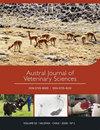Genetic structure and population dynamics of autochthonous and modern porcine breeds. Analysis of the IGF2 and MC4R genes that determine carcass characteristics
IF 0.5
4区 农林科学
Q3 VETERINARY SCIENCES
引用次数: 1
Abstract
To know the genetic situation of the Pampa Rocha, Celta, Bizaro Portuguese, Duroc, Iberian Extremeno and Iberian Andalusian porcine populations, their genetic structure and population dynamics were studied on the IGF2 and MC4R genes, which determine meat characteristics and quality. The degree of genetic variability (He = 0.2511 in Pampa Rocha; 0.0278 in Celta; 0,1453 in Bizaro Portuguese; 0.3719 in Duroc; 0.0764 in Iberian Extremeno and 0.0384 in Iberian Andalusian), genetic distance, and the presence or absence of consanguinity were studied. The Fis values were positive for the Duroc population (0.00426) indicating a very low inbreeding, the rest of the populations did not present consanguinity. Significant deviations (P ≤ 0.05) in the Hardy-Weinberg (HW) equilibrium were obtained for the IGF2 locus in Celta, Iberian Extremeno, and Iberian Andalusian populations with the G allele fixed, while the Bizaro Portuguese, Pampa Rocha, and Duroc populations presented polymorphism, the G allelic frequency was much higher than A allele, except in the Duroc breed (0.15). These findings could help breeders to increase the presence of the A allele for the improvement of muscle mass and reduction in the back-fat thickness in this breed. All the studied populations presented polymorphism for the MC4R locus with different frequencies for each allele. Furthermore, these results could allow developing strategies against anthropogenic activities that hinder the conservation of the biodiversity of these porcine breeds.本地和现代猪品种的遗传结构和种群动态。决定胴体性状的IGF2和MC4R基因分析
为了了解Pampa-Rocha、Celta、Bizaro Portugal、Duroc、Iberian Extremeno和Iberian Andalusian猪群的遗传状况,对决定肉质和肉质的IGF2和MC4R基因进行了遗传结构和群体动力学研究。研究了遗传变异程度(潘帕罗查He=0.251;塞尔塔0.0278;比扎罗葡萄牙语01453;杜洛克0.3719;伊比利亚埃斯特雷梅诺0.0764和伊比利亚安达卢西亚0.0384)、遗传距离和是否有血缘关系。杜洛克种群的Fis值为正(0.00426),表明近亲繁殖率很低,其余种群没有血缘关系。在G等位基因固定的塞尔塔、伊比利亚埃斯特雷梅诺和伊比利亚-安达卢西亚群体中,IGF2基因座在Hardy-Weinberg(HW)平衡中存在显著偏差(P≤0.05),而比扎罗-葡萄牙、潘帕-罗查和杜洛克群体呈现多态性,G等位频率远高于A等位基因,除了杜洛克品种(0.15)。这些发现可以帮助育种家增加A等位基因的存在,以改善该品种的肌肉质量和减少背部脂肪厚度。所有研究的群体都表现出MC4R基因座的多态性,每个等位基因的频率不同。此外,这些结果可以制定策略,对抗阻碍保护这些猪品种生物多样性的人为活动。
本文章由计算机程序翻译,如有差异,请以英文原文为准。
求助全文
约1分钟内获得全文
求助全文
来源期刊

Austral Journal of Veterinary Sciences
Veterinary-General Veterinary
CiteScore
1.60
自引率
0.00%
发文量
18
期刊介绍:
Austral Journal of Veterinary Sciences (formerly Archivos de Medicina Veterinaria) publishes original scientific contributions in English, containing the latest developments and discoveries in veterinary sciences. The journal covers topics such as animal health and production, preventive medicine, zoonosis, pharmacology and therapeutics, methods of diagnosis, and other areas related to the veterinary field.
Austral Journal of Veterinary Sciences aims to divulge information about advances in veterinary medicine among universities, research centres, industries, government agencies, biologists, agronomists and veterinarians.
 求助内容:
求助内容: 应助结果提醒方式:
应助结果提醒方式:


